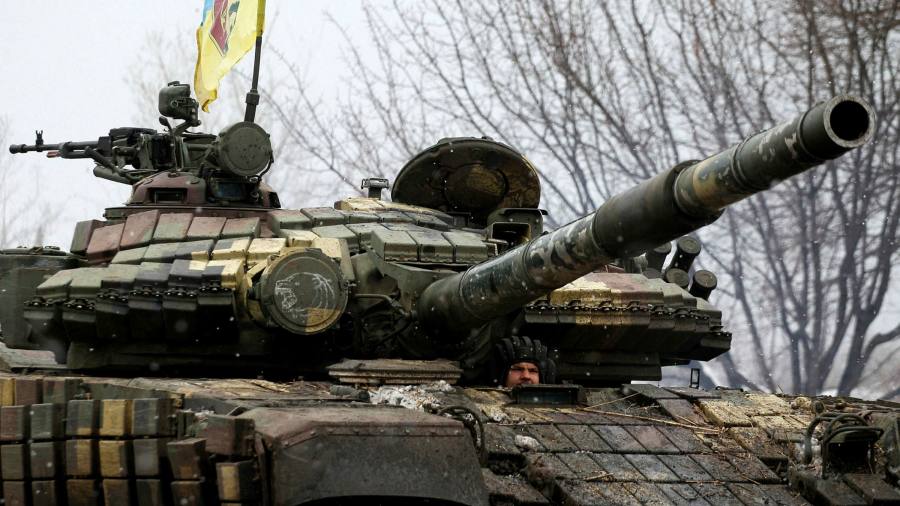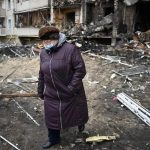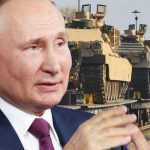Three weeks into its invasion of Ukraine, the scale of Russia’s military blunders is becoming clear.
The outcome of Russian president Vladimir Putin’s war is still far from certain: little information exists on Ukrainian forces’ rates of attrition, while Russia’s military still outmans and outguns that of its neighbour. The chances of escalation have meanwhile increased as the Russian leadership looks to regain the front foot.
But in the first phase of its offensive, the Kremlin’s military story is one of failure.
Western defence officials have estimated Russian casualties at between 2,000 and 6,000. Based on ratios in similar conflicts, that implies three to four times as many captured and wounded. At its midpoint, such an estimate is more, in three weeks, than the losses of US and UK servicemen combined during 20 years in Afghanistan.
Russia’s losses in materiel are also significant. The Oryx blog has recorded 1,034 Russian vehicles, artillery pieces and aircraft destroyed, damaged, abandoned or captured. These include 173 tanks, 261 armoured and infantry fighting vehicles, and 28 surface-to-air missile systems.
Justin Bronk, research fellow at the UK’s Royal United Services Institute, who co-wrote a book on Russia’s military modernisation under Putin, said the losses “are massively more than in any other recent conflict” including Georgia, Chechnya or Afghanistan in the 1980s.
Analysts and western military officials agree on the primary cause of the flaws in Russia’s military offensive: a failure of intelligence that skewed military planning.
Flowing from this were failures linked to rash decision-making, logistical unpreparedness, poor maintenance of equipment and the use of young, inexperienced troops that together have culminated in a collapse of front-line Russian morale.
General Sir Richard Barrons, former head of the UK’s Joint Forces Command, said: “There is something here that is systemically wrong . . . somewhere in the Russian intelligence architecture, facts on the ground are being converted into an analysis, but that analysis is actually a narrative to support the preconceptions of the senior [Kremlin] leadership.”
As a result, Russia’s intended campaign — an assault strike predicated on speed and Ukrainian political weakness — has tipped into a joint combat operation requiring logistical and communications planning that does not seem to have been in place, say analysts.
Russia’s first failures occurred within the opening 24 hours of the war, when pre-positioned covert spetsnaz troops, whose job it was to cripple the Ukrainian political leadership, were stopped. Airborne forces of the elite VDV, known for their sky-blue berets, that were supposed to secure key sites such as Hostomel airport just north of the capital, were, after initial success, repelled by strong Ukrainian resistance. Two transport aircraft were downed above Hostomel by Ukrainian forces.
“The Ukrainian military as a whole have been expecting this kind of invasion to come since 2014,” said Barrons. “And then they were handed the gift of these light forces coming in piecemeal, underestimating them, which they were able to pick off.”
The second component of the initial assault — the rapid advance of Russian forces, avoiding cities and intended to quickly encircle regional Ukrainian military units they believed would be paralysed because of a leaderless central government — further extended Russian vulnerability.
“It is as if they were treating this as a military policing mission, not an actual invasion against a modern military,” said one western military official. Videos on social media even show troops from Rosguardia, Russia’s domestic militia, advancing into towns, unsupported, as the frontline force.
When, several days in, Russian commanders realised they needed to pivot to using more serious firepower, they did so chaotically: huge columns of tanks and artillery moved forward, but the Ukrainians blew up bridges, causing advances to stall. Russian planners appear to have failed to anticipate this basic response, another western military official said, pointing out that engineering units and bridge builders were not even near the front of the advance in some columns.
“What we have seen on the ground is an extremely bad plan coupled with absolutely no warning to operational commanders they were about to throw their troops into operational combat which has created an enormous number of problems for them,” said Rusi’s Bronk. It is, he added, a “serious failure” of “TTPs” — tactics, techniques and procedures.
Even Russia’s feared anti-aircraft systems were left vulnerable to cheap Turkish Bayraktar TB2 drones operated by the Ukrainians. Footage on Twitter, for example, shows Ukrainian TB2’s picking off Buk launchers, the same missile system used to shoot down the MH17 commercial aircraft in 2014.
On the ground, meanwhile, the thousands of anti-tank missiles western powers have been supplying to Ukraine for weeks have proved effective, with mobile foot soldiers able to ambush and attack isolated advanced clusters of Russian light vehicles and stationary heavy units stuck in columns with unprotected flanks.
Open-source intelligence suggests that Russia’s military communications infrastructure has performed poorly: the cutting-edge encrypted Azart and Akveduk radios that supposedly began to be rolled out to Russian units in 2017 appear to be in short supply or have inadequate range, noted a Rusi report.
On social media, pictures have been posted of Russians using cheap, unencrypted Chinese radios, and their own mobile phones to contact commanders. As a result even amateur radio enthusiasts hundreds of miles away have been able to tune into real-time Russian military communications, as Twitter threads with dozens of recorded Russian messages show.

Inadequate equipment has been the cause of other failings: images have been shared by Ukrainians of Russian vehicles with shredded tires stuck in mud. Experts say the tires are almost certainly cheap, civilian-grade versions of those the Russian military need, suggesting, as in the case of the radios, endemic corruption in Russia’s defence procurement.
“The Russians are very good at military parades. They spend weeks getting everything shiny. But it’s a facade,” said one European defence official.
The biggest question that continues to perplex analysts, though, is why Russia has still not made use of its vastly superior air power to better protect its forces, and reverse the debacle on the ground.
A senior US defence official said that Ukraine had been “very creative” in how it used its air defences, making highly effective use of cheap drones, and the country’s forces were staging a much fiercer resistance than Russian intelligence expected. “They are putting resources where they’re most needed [and] they’re doing it quickly. They are being adaptive and nimble . . . in almost a sort of a hit-and-run kind of style,” he said.
Russia’s military has no experience fighting such an extensive joint ground-and-air war, the official said. “This is an operation that they have never conducted before, never meaning since world war two.”
The official said Russia was also having trouble integrating its ground and air forces into a “joint” force. He said that while the Russia had upgraded its military and acquired sophisticated systems, “it doesn’t appear . . . that they have developed the proper operational concepts to use these modern capabilities”.
The failures have resulted in a widespread, if perhaps temporary, collapse in morale, according to the Pentagon and British defence intelligence. There is even evidence of Russian soldiers sabotaging their own equipment, officials have said.
The average age of Russian soldiers in Ukraine is 20-25 years old, according to one western military official, compared with 30-35 for the Ukrainians, who are better-supplied and have a cause on their side.
Many of the young Russian soldiers deployed meanwhile did not even know they were being sent into Ukraine, let alone that they would have to fire on fellow Russian-speakers.
“It has become clear that a lot of Russian infantry are simply not willing to go into the attack,” said Chris Donnelly, an adviser on the Soviet military to four Nato secretaries-general. “Once morale really starts to collapse like this, you don’t have an army any more.”
The Russians have used conscripts and poorly trained junior troops, Donnelly said, in an apparently knee-jerk reversion by operational commanders to the textbook Soviet tactic of sending in expendable forces first to “soak up firepower”.
The question is how Russia will adapt. In recent days, Russian forces have stepped up the use of long-range fire, and have launched more than 800 missiles in total. There were also signs that columns of forces to the north and east of Kyiv were preparing to try a new approach.
Some of the tanks and other vehicles in a long convoy that at its closest point is 15km from Kyiv have also gone off the main road. It is unclear whether they are being sent in a different direction or taking cover under trees.
Elsewhere, Russia’s objectives seem to be to surround and besiege a sufficient number of Ukrainian cities, seize Kyiv and oust the Zelensky government. While Russian forces have struggled in the north, in the south they have had far more success, and can still apply considerable force.
Questions remain about Ukrainian forces’ ability to continue to fight and how much in anti-aircraft munitions they have remaining.
Within the Ukrainian military there is also growing dismay over western flip-flopping over additional military support, such as gifting MiG jets or heavier, vehicle-mounted long-range anti-aircraft weaponry.
Russia’s use of crude artillery and dumb bombs is meanwhile wreaking a heavy civilian toll. And most signs point towards a further escalation by the Kremlin.
The danger, said one retired senior British intelligence officer, is that in seeking to extricate itself from its tactical disasters in Ukraine, Moscow “blunders into a strategic dead-end with even worse consequences” — for Ukraine, and possibly the world.
Source: FT





